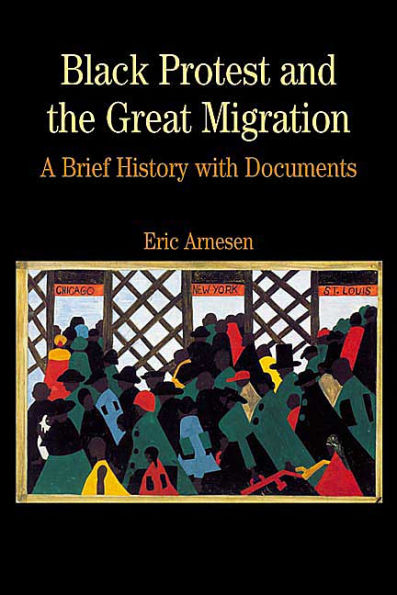Table of Contents
Foreword Preface PART ONE Introduction: The Great American Protest Origins of the Great Migration
Wartime Opportunities in the North
The Promised Land?
Wartime Black Leaders, the New Negro, and Grassroots Politics
Racial Violence and the Postwar Reaction to Black Activism
Consequences of the Migration
PART TWO The Documents 1. The Great Migration Begins Why They Left: Conditions in the South W. E. B. Du Bois,
The Migration of Negroes, June 1917
Mary DeBardeleben,
The Negro Exodus: A Southern Woman’s View, March 18, 1917
Charles S. Johnson,
How Much Is the Migration a Flight from Persecution? September 1923
White Southerners Respond to the Migration McDowell Times,
1100 Negroes Desert Savannah, Georgia, August 11, 1916
New Orleans Times-Picayune,
Luring Labor North, August 22, 1916
Southern Blacks’ Warnings about Migration J. A. Martin,
Negroes Urged to Remain in South, November 25, 1916
Percy H. Stone,
Negro Migration, August 1, 1917
Letters from Migrants Documents: Letters of Negro Migrants, 1916–1918 64
2. The Promised Land?
The Truth about the North
Chicago Commission on Race Relations, The Arrival in Chicago, 1922
Southwestern Christian Advocate, Read This Before You Move North, April 5, 1917
Dwight Thompson Farnham, Negroes a Source of Industrial Labor, August 1918
The East St. Louis Riot 78
New Orleans Times-Picayune,
The Negro in the North, June 4, 1917Crisis,
The Massacre of East St. Louis, September 1917Chicago Defender,
Thousands March in Silent Protest, August 4, 1917
3. The Evolution of Black Politics
Patriotism and Military Service
The Reverend J. Edward Pryor,
The Patriotism of the Negro, May 4, 1917
W. E. B. Du Bois,
Close Ranks, July 1918
The New Republic,
Negro Conscription, October 20, 1917
Leon A. Smith,
Protest to Boston Herald, April 20, 1918
Martha Gruening,
Houston: An NAACP Investigation, November 1917
Savannah Tribune,
Racial Clashes, July 26, 1919
The Emergence of the New Negro during and after the War Cleveland Gazette,
League Asks Full Manhood Rights, May 19, 1917
Crisis,
The Heart of the South, May 1917
Mary White Ovington,
Reconstruction and the Negro, February 1919
The Messenger,
Migration and Political Power, July 1918
Marcus Garvey,
What We Believe, January 1, 1924, and
The Principles of the Universal Negro Improvement Association,November 25, 1922
The Messenger,
New Leadership for the Negro, May –June 1919
The Messenger,
If We Must Die, September 1919
Geroid Robinson,
The New Negro, June 2, 1920
Black Women, Protest, and the Suffrage Colored Federated Clubs of Augusta,
Letter to President Woodrow Wilson, May 29, 1918
New York Age,
Campaign for Women Nearing Its Close, November 1, 1917
Savannah Morning News,
Negro Women Seek Permission to Vote, November 3, 1920 126
4. Black Workers and the Wartime Home Front Black Men and the Labor Question Crisis,
Trades Unions, March 1918
United Mine Workers Journal, From Alabama: Colored Miners Anxious for Organization, June 1, 1916
Raymond Swing,
The Birmingham Case, 1918
New Orleans Times-Picayune,
Negro Organizer Tarred, June 14, 1918
Birmingham Ledger,
Negro Strikers Return to Work, October 3, 1918
Black Women and the War Houston Labor Journal,
Colored Women of Houston Organize, May 6, 1916
Tampa Morning Tribune,
Negro Washerwomen to Have Union Wage Scale, October 10, 1918
Mobile Register,
Workers Strike in Laundries to Get Higher Pay, April 23, 1918
Mobile News-Item,
Negro Women Are Under Arrest in Laundry Strike, April 25, 1918
Tampa Morning Tribune,
Negro Women Living in Idleness Must Go to Work or to Jail, October 17, 1918
Savannah Tribune,
Negroes to Demand Work at Charleston Navy Yard, May 19, 1917
5. Opportunities and Obstacles in the Postwar Era An Uncertain Future James W. Johnson,
Views and Reviews: Now Comes the Test, November 23, 1918
Forrester B. Washington,
Reconstruction and the Colored Woman, January 1919
George E. Haynes, William B. Wilson, and Sidney J. Catts,
Letters from the U.S. Department of Labor Case Files, 1919
Mary White Ovington,
Bogalusa, January 1920
Chicago Whip,
Colored Labor Delegation Demands Rights in Alabama, February 28, 1920
George Schuyler,
Negroes in the Unions, August 1925
1919 Riots Washington Bee,
The Rights of the Black Man, August 2, 1919
Jackson (Mississippi) Daily News,
Race Riots in Chicago, July 28, 1919
Graham Taylor,
Chicago in the Nation’s Race Strife, August 9, 1919
The Elaine Massacre Newport News Times-Herald,
Slowly Restore Order Today in Riot Districts, October 3, 1919
Walter F. White,
The Race Conflict in Arkansas, December 13, 1919
Pittsburgh Courier,
How the Arkansas Peons Were Freed, July 28, 1923
6. Postwar Migration Heading South? or Coming North?
Jackson (Mississippi) Daily News,
Chi Negroes Ask to Return to Mississippi, August 1, 1919
Tampa Morning Tribune,
Negroes Who Come to South Are Better Off, August 24, 1919, and
Find the Southern Negro Prosperous, October 5, 1919
T. Arnold Hill,
Why Southern Negroes Don’t Go South, November 29, 1919
Buffalo American,
Mighty Exodus Continues; Cause Not Economic, July 22, 1920
Building a New Life in the North Charles S. Johnson,
These Colored United States, December 1923
George E. Haynes,
Negro Migration: Its Effect on Family and Community Life in the North, October 1924
and the Harlem Renaissance Alain Locke,
The New Negro, 1925
APPENDIXES Chronology of Events Related to the Great Migration (1865–1925)
Questions for Consideration
Selected Bibliography
Index



